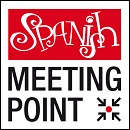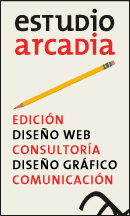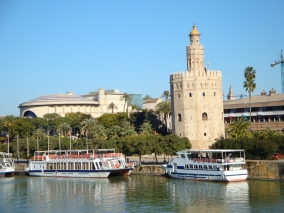Spanish schools and accommodation to study Spanish in Spain
Recent posts
Last schools
introduced
introduced
5 Accommodation

2 Spanish schools

Learning Spanish in Seville. The tourist guide to study your Spanish course.
General Information. 1,500,000 inhabitants in its metropolitan area. 530 kilometres southeast of Madrid. Seville is the capital of the Autonomous Community of Andalusia and the fourth most populated city in Spain after Madrid, Barcelona and Valencia. Its old quarter is one of the largest in Europe. It is situated just 6 metres above sea level on the fertile low-lying plains of the Guadalquivir River. Thanks to its Mediterranean climate, Seville enjoys nearly 3,000 hours of sunlight a year. The city is the artistic, cultural and financial centre of southern Spain, with an airport and good road and rail links, including the High Speed (AVE) network. It also has a river port, where docking facilities have been expanded to cater for cruise ships. Seville is a cheerful and welcoming city where the locals like to live and intermingle in the streets, creating a warm and friendly atmosphere. Seville is the heart of Andalusian culture and the world capital of bullfighting and flamenco. The city has an outstanding choice of schools in which to study the Spanish language. The University of Seville was founded in 1505, and over 55,000 students enrol there every year. In Dos Hermanas there is another public university (Universidad Pablo de Olavide) with more than 10,000 students. Seville is one of the most popular destinations among Erasmus students. Seville is a very attractive place to study Spanish with many language schools offering a wide range of courses.
Surrounding Areas. The Roman Ruins of Italica, a residential city in Roman times, can be found in Santiponce (8 kilometres); the Doñana Nature Reserve (Parque Nacional de Doñana, 30 kilometres) is a vast wetland area which was declared a UNESCO World Heritage Site in 1994; the town of Carmona (33 kilometres) has an important historical and artistic heritage and is surrounded by Carthaginian ramparts which were later developed by the Romans. Écija (88 kilometres), known as the ‘city of towers' for its many church towers, also has a rich historical past. Cádiz (120 kilometres).
World Heritage Site. The Cathedral, which is the largest Gothic building in the world, the Citadel (El Alcázar) and the Archive of the Indies (Archivo de Indias) were declared World Heritage Sites by UNESCO in 1987.
Main Sights. The Cathedral, which began to be built in the 12th century on the site of an old mosque whose famous minaret, La Giralda, has long been used as a bell tower, stands at an impressive height of 104.5 metres. El Alcázar, the oldest currently used royal residence in Europe, occasionally hosts institutional ceremonies and exhibitions. The Archivo de Indias, designed as a repository for all the documents relating to the history of the Spanish Empire in the Americas, was created in 1785 under the reign of Charles III of Spain. The Gold Tower (Torre del Oro), situated on the bank of the Guadalquivir River, was declared a monument of historic-artistic merit in 1931. The 18th century bullring, whose full name is the Plaza de Toros de la Real Maestranza. Triana Bridge (Puente de Triana), which was built to replace a wooden boat bridge. The Isla Mágica theme park, situated on the island of La Cartuja, part of which was used as the site of the 1992 Universal Exhibition. Seville has countless parks and promenades running alongside the Guadalquivir, where there are several quays which offer the opportunity to see the city by boat. The Aquopolis water park.
Culture. The most important festivals in Seville are: La Bienal de Flamenco, a biannual festival which over the last 20 years has given flamenco artists the opportunity to showcase their work in various theatres across the city; and the Seville European Film Festival, currently organized by the City Council. As for museums, it is worth highlighting the Museum of Fine Arts (Museo de Bellas Artes de Sevilla), the most visited in Andalusia and the second most important art gallery in Spain, the Archaeological Museum, and the Flamenco Dance Museum (Museo de Baile Flamenco). The main theatres are the Teatro de la Maestranza and the Teatro Lope de Vega, built in 1929.
Shopping. The streets of the old quarter are full of fashion shops, with boutiques selling the creations of renowned Andalusian designers such as Victorio & Lucchino and Toni Benítez. Calle Sierpes and Calle Tetuán, two streets which run parallel to each other, have the highest concentration of clothing outlets, shoe shops, jeweller's, souvenir stores... Seville also has numerous street markets: the Mercadillo del Jueves, as its name indicates, takes place every Thursday in Calle Feria, in the Macarena neighbourhood; the weekend Mercadillo del Charco de la Pava, on the island of La Cartuja; the Mercadillo del Parque Alcosa; and the Mercadillo de Animales, a colourful market of pet stalls situated on Avenida Juan Carlos I.
Gastronomy. Seville is renowned for its generous tapas, which are something of a gastronomic institution and can be sampled all over the city. The quintessentially Spanish custom of snacking on a variety of tasty morsels while bar-hopping is the best way to try some of the local delicacies (stews, deep-fried fish, macerated pork, dressings...) and discover a much-cherished aspect of everyday life in Seville. The Santa Cruz, Alameda and Triana neighbourhoods are among the best areas for a tapas crawl. There are many good restaurants scattered throughout the city, and the most typical dishes are gazpacho (a chilled soup made from puréed bread and garlic, with raw peppers, tomato and cucumber), ensaladilla rusa (a "Russian salad" made with diced potatoes, tuna, peas, carrots and mayonnaise), pescaito frito (portions of deep-fried fish), rabo de toro (bull's tail slowly stewed with tomato and onion), tortillitas de camarones (shrimp omelettes), pringá (a mixture of tender roasted pork, pork fat and cured sausage meat), ensaladas (salads) and cocido andaluz (the inclusion of pumpkin makes for a slightly sweeter variation on this national dish, a hearty chick-pea stew with an array of vegetables and traditional pork cuts).
Sports. Seville has two first division football teams: Sevilla Club de Fútbol, who play their home games at the Ramón Sánchez Pizjuán stadium, and arch rivals Club Real Betis Balompié, who play at the Manuel Ruiz de Lopera stadium. The Palacio de Deportes San Pablo, an indoor sports arena, is the home of the CajaSol Sevilla basketball team, who compete in the ACB League, the first division in Spain. The city's biggest sporting venue is the Estadio Olímpico de La Cartuja, where you can play or learn almost any sport. The Guadalquivir River is used for a wide variety of water sports, such as rowing and canoeing, and there are several golf courses within easy reach of the city.
Fiestas. Holy Week in Seville, officially declared an Event of International Tourist Interest, is probably the most famous in Spain. The most representative local fiesta is the April Fair (Feria de Abril), where flamenco, horse-drawn carriage parades, bullfights, tapas and sherry all play a major part in the celebrations. This vibrant and colourful extravaganza gets under way eight days before Holy Week and takes place in the Los Remedios neighbourhood, where there is a funfair with more than 400 different attractions and over 1,000 casetas, the traditional tents in which families, friends and visitors gather to eat, drink and dance the week away.
Transport. Seville has excellent national and international transport connections thanks to its airport, motorways and rail networks; there is a high speed (AVE) line linking it to Madrid in two and half hours. Sevilles's first tram line opened in 2007, and several metro lines entered into operation in 2009. For guided tours of the city, there is a sightseeing bus which allows you to hop on and off at any of the stops on the route as and when you please. It is easy to get from Seville to other Spanish cities by train or by using the various coach services.
Nightlife. Students who decide to study Spanish in Seville will discover a very active nightlife, thanks to the city's university atmosphere. In autumn and winter, the busiest areas are the city centre, El Arenal and the Santa Cruz neighbourhood, with its traditional bars and taverns. A more alternative scene can be found in areas such as La Alfalfa, La Alameda and Plaza del Salvador. The Triana neighbourhood also has a distinctive night-time atmosphere, and the Reina Mercedes area is especially popular among the student crowd. During the summer, the focal point of the city's nightlife shifts towards the numerous outdoor bars and open-air discos spread along the riverbank. The college life is a major attraction for the many students who decide to study Spanish in Seville.
Surrounding Areas. The Roman Ruins of Italica, a residential city in Roman times, can be found in Santiponce (8 kilometres); the Doñana Nature Reserve (Parque Nacional de Doñana, 30 kilometres) is a vast wetland area which was declared a UNESCO World Heritage Site in 1994; the town of Carmona (33 kilometres) has an important historical and artistic heritage and is surrounded by Carthaginian ramparts which were later developed by the Romans. Écija (88 kilometres), known as the ‘city of towers' for its many church towers, also has a rich historical past. Cádiz (120 kilometres).
World Heritage Site. The Cathedral, which is the largest Gothic building in the world, the Citadel (El Alcázar) and the Archive of the Indies (Archivo de Indias) were declared World Heritage Sites by UNESCO in 1987.
Main Sights. The Cathedral, which began to be built in the 12th century on the site of an old mosque whose famous minaret, La Giralda, has long been used as a bell tower, stands at an impressive height of 104.5 metres. El Alcázar, the oldest currently used royal residence in Europe, occasionally hosts institutional ceremonies and exhibitions. The Archivo de Indias, designed as a repository for all the documents relating to the history of the Spanish Empire in the Americas, was created in 1785 under the reign of Charles III of Spain. The Gold Tower (Torre del Oro), situated on the bank of the Guadalquivir River, was declared a monument of historic-artistic merit in 1931. The 18th century bullring, whose full name is the Plaza de Toros de la Real Maestranza. Triana Bridge (Puente de Triana), which was built to replace a wooden boat bridge. The Isla Mágica theme park, situated on the island of La Cartuja, part of which was used as the site of the 1992 Universal Exhibition. Seville has countless parks and promenades running alongside the Guadalquivir, where there are several quays which offer the opportunity to see the city by boat. The Aquopolis water park.
Culture. The most important festivals in Seville are: La Bienal de Flamenco, a biannual festival which over the last 20 years has given flamenco artists the opportunity to showcase their work in various theatres across the city; and the Seville European Film Festival, currently organized by the City Council. As for museums, it is worth highlighting the Museum of Fine Arts (Museo de Bellas Artes de Sevilla), the most visited in Andalusia and the second most important art gallery in Spain, the Archaeological Museum, and the Flamenco Dance Museum (Museo de Baile Flamenco). The main theatres are the Teatro de la Maestranza and the Teatro Lope de Vega, built in 1929.
Shopping. The streets of the old quarter are full of fashion shops, with boutiques selling the creations of renowned Andalusian designers such as Victorio & Lucchino and Toni Benítez. Calle Sierpes and Calle Tetuán, two streets which run parallel to each other, have the highest concentration of clothing outlets, shoe shops, jeweller's, souvenir stores... Seville also has numerous street markets: the Mercadillo del Jueves, as its name indicates, takes place every Thursday in Calle Feria, in the Macarena neighbourhood; the weekend Mercadillo del Charco de la Pava, on the island of La Cartuja; the Mercadillo del Parque Alcosa; and the Mercadillo de Animales, a colourful market of pet stalls situated on Avenida Juan Carlos I.
Gastronomy. Seville is renowned for its generous tapas, which are something of a gastronomic institution and can be sampled all over the city. The quintessentially Spanish custom of snacking on a variety of tasty morsels while bar-hopping is the best way to try some of the local delicacies (stews, deep-fried fish, macerated pork, dressings...) and discover a much-cherished aspect of everyday life in Seville. The Santa Cruz, Alameda and Triana neighbourhoods are among the best areas for a tapas crawl. There are many good restaurants scattered throughout the city, and the most typical dishes are gazpacho (a chilled soup made from puréed bread and garlic, with raw peppers, tomato and cucumber), ensaladilla rusa (a "Russian salad" made with diced potatoes, tuna, peas, carrots and mayonnaise), pescaito frito (portions of deep-fried fish), rabo de toro (bull's tail slowly stewed with tomato and onion), tortillitas de camarones (shrimp omelettes), pringá (a mixture of tender roasted pork, pork fat and cured sausage meat), ensaladas (salads) and cocido andaluz (the inclusion of pumpkin makes for a slightly sweeter variation on this national dish, a hearty chick-pea stew with an array of vegetables and traditional pork cuts).
Sports. Seville has two first division football teams: Sevilla Club de Fútbol, who play their home games at the Ramón Sánchez Pizjuán stadium, and arch rivals Club Real Betis Balompié, who play at the Manuel Ruiz de Lopera stadium. The Palacio de Deportes San Pablo, an indoor sports arena, is the home of the CajaSol Sevilla basketball team, who compete in the ACB League, the first division in Spain. The city's biggest sporting venue is the Estadio Olímpico de La Cartuja, where you can play or learn almost any sport. The Guadalquivir River is used for a wide variety of water sports, such as rowing and canoeing, and there are several golf courses within easy reach of the city.
Fiestas. Holy Week in Seville, officially declared an Event of International Tourist Interest, is probably the most famous in Spain. The most representative local fiesta is the April Fair (Feria de Abril), where flamenco, horse-drawn carriage parades, bullfights, tapas and sherry all play a major part in the celebrations. This vibrant and colourful extravaganza gets under way eight days before Holy Week and takes place in the Los Remedios neighbourhood, where there is a funfair with more than 400 different attractions and over 1,000 casetas, the traditional tents in which families, friends and visitors gather to eat, drink and dance the week away.
Transport. Seville has excellent national and international transport connections thanks to its airport, motorways and rail networks; there is a high speed (AVE) line linking it to Madrid in two and half hours. Sevilles's first tram line opened in 2007, and several metro lines entered into operation in 2009. For guided tours of the city, there is a sightseeing bus which allows you to hop on and off at any of the stops on the route as and when you please. It is easy to get from Seville to other Spanish cities by train or by using the various coach services.
Nightlife. Students who decide to study Spanish in Seville will discover a very active nightlife, thanks to the city's university atmosphere. In autumn and winter, the busiest areas are the city centre, El Arenal and the Santa Cruz neighbourhood, with its traditional bars and taverns. A more alternative scene can be found in areas such as La Alfalfa, La Alameda and Plaza del Salvador. The Triana neighbourhood also has a distinctive night-time atmosphere, and the Reina Mercedes area is especially popular among the student crowd. During the summer, the focal point of the city's nightlife shifts towards the numerous outdoor bars and open-air discos spread along the riverbank. The college life is a major attraction for the many students who decide to study Spanish in Seville.
© TEXT: SPANISH IN TOUR.
VIDEO: Patronato de Turismo de Sevilla
VIDEO: Patronato de Turismo de Sevilla

























